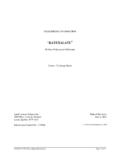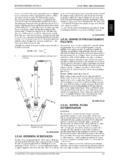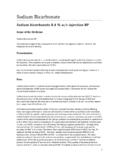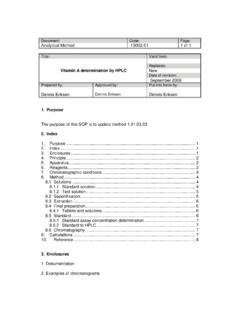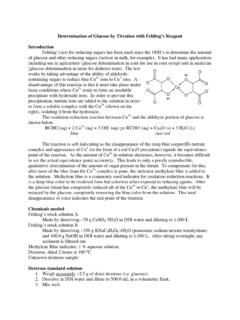Transcription of Sodium Aluminium Silicate - fao.org
1 0 out of 3 FAO/WHO 2017 Residue Monograph prepared by the meeting of the Joint FAO/WHO Expert Committee on Food Additives (JECFA), 84th meeting 2017 Sodium Aluminium Silicate This monograph was also published in: Compendium of Food Additive Specifications. Joint FAO/WHO Expert Committee on Food Additives (JECFA), 84th meeting 2017. FAO JECFA Monographs 20 1 out of 3 FAO/WHO 2017 Sodium Aluminium Silicate Prepared at the 84th JECFA and published in FAO JECFA Monograph 20 (2017), superseding tentative specifications prepared at the 80th JECFA (2015) and published in FAO JECFA Monographs 17 (2015). An ADI 'not specified' for silicon dioxide and certain silicates was established at the 29th JECFA (1985). A PTWI of 2 mg/kg bw for total Aluminium was established at the 74th JECFA (2011).
2 The PTWI applies to all Aluminium compounds in food, including food additives. SYNONYMS Sodium silicoaluminate; Sodium aluminosilicate; Aluminium Sodium Silicate ; silicic acid, Aluminium Sodium salt; INS No. 554 DEFINITION Sodium Aluminium Silicate is a series of amorphous hydrated Sodium Aluminium silicates with varying proportions of Na2O, Al2O3 and SiO2. It is manufactured by reacting Aluminium sulphate and Sodium Silicate followed by precipitation. Chemical names Aluminium Sodium Silicate number 1344-00-9 Chemical formula xSiO2 yAl2O3 zNa2O Assay Silicon dioxide (SiO2): Not less than 66% and not more than 88%. Aluminium oxide (Al2O3): Not less than 5% and not more than 15%. Sodium oxide (Na2O): Not less than 5% and not more than All values expressed on the dried basis.
3 DESCRIPTION Odourless, fine, white amorphous powder, or as beads FUNCTIONAL USES Anticaking agent CHARACTERISTICS IDENTIFICATION 2 out of 3 FAO/WHO 2017 Solubility (Vol. 4) Insoluble in water. Test for Sodium Passes test See description under TESTS Test for Aluminium Passes test See description under TESTS Test for silicon Passes test See description under TESTS PURITY pH (Vol. 4) (5% slurry) Loss on drying (Vol. 4) Not more than (105 , 2 h). Loss on ignition (Vol. 4) Not less than and not more than on the dried basis (1000 , constant weight). Impurities soluble in M hydrochloric acid Lead: Not more than 5 mg/kg Arsenic: Not more than 3 mg/kg Mercury: Not more than 1 mg/kg See description under TESTS TESTS IDENTIFICATION TESTS Test for Aluminium , Sodium and silicon Prepare the test solution as shown under method of assay.
4 Analyse Aluminium , Sodium and silica in the test solution by ICP-AES technique (Vol. 4). Set instrument parameters as specified by the instrument manufacturer, use analytical lines for Al ( nm), Na ( nm) and Si ( nm). PURITY TESTS Impurities soluble in M hydrochloric acid Extract a known quantity of finely ground sample using closed system digestion (to prevent loss of arsenic and mercury) with M hydrochloric acid (spectroscopic grade) for 30 min. Let solution cool, then filter through a m membrane filter. Wash the filter twice with M hydrochloric acid. Combine the filtrate and wash solution and make up to a known volume with 3 out of 3 FAO/WHO 2017 M hydrochloric acid. Determine using a method appropriate to the specified level METHOD OF ASSAY Weigh about g of the sample to the nearest mg, in a platinum or nickel crucible, add 5 g potassium hydroxide and 2 g boric acid, mix and melt completely using a torch burner and allow to stand at room temperature.
5 Place the reaction product along with crucible into 150 mL hot deionized water in a 250-mL PTFE beaker and dissolve residue by agitation. Wash the crucible with hot deionized water and remove it. Add 50 mL hydrochloric acid and transfer the contents into a 250-mL polypropylene volumetric flask. Wash the beaker three times with hot deionized water, transfer the washings to the volumetric flask and make up to volume. Dilute with 2% hydrochloric acid and prepare the test solution. Analyse Aluminium , Sodium , and silica in the test solution by ICP-AES technique (Vol. 4). Set instrument parameters as specified by the instrument manufacturer. Use analytical lines for Al ( nm), Na ( nm) and Si ( nm). Construct standard curve using standard solutions g/mL each.
6 Read the concentration of Al, Na and Si, in sample solution (as g/mL). Conduct as a blank determination following the above procedure. Calculate the content of Aluminium oxide, Sodium oxide and silicon dioxide in the sample using the formulas: 2 3 (%)=1. 889 ( ) 250 106 100 2 (%)=1. 348 ( ) 250 106 100 2 (%)=2. 139 ( ) 250 106 100 Where: - C ( g/mL) is concentration of Al or Na or Si in the test solution, - B ( g/mL) is concentration of Al or Na or Si in the blank solution, - W is weight of sample on the ignited basis, - DF is dilution factor










